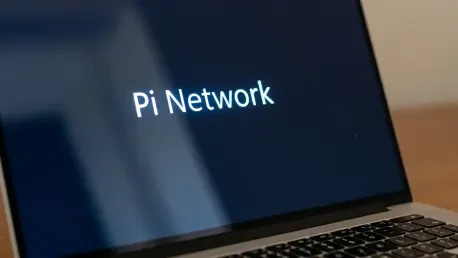Imagine a world where shopping in a high-end mall doesn’t involve swiping a credit card or fumbling with cash, but instead, a quick tap on a mobile app using a digital currency that bypasses banks entirely. This scenario is no longer a distant dream but a tangible reality being shaped by Pi Network, a cryptocurrency platform that aims to revolutionize retail through decentralized payments. With its native currency, Picoin, and a visionary concept like the Luxury City Mall of the Future, Pi Network is carving a niche in the decentralized finance (DeFi) landscape. This review dives deep into the technology behind Pi Network’s payment system, exploring its features, real-world applications, and the challenges it faces in transforming commerce.
Core Technology and Features of Pi Network
Picoin as a Transactional Currency
At the heart of Pi Network’s ecosystem lies Picoin, a digital currency designed not for speculation but for practical use in transactions. Unlike many cryptocurrencies driven by volatile market trends, Picoin’s value is rooted in user contributions through mobile mining and identity verification, fostering a sense of trust and stability. This design enables seamless exchanges for a variety of goods and services, positioning Picoin as a viable medium for everyday commerce.
The technology supporting Picoin emphasizes accessibility, allowing users to mine currency directly from their smartphones without the need for energy-intensive hardware. This approach democratizes participation, ensuring that even individuals with minimal technical expertise can engage with the system. The focus on real-world utility sets Picoin apart in a crowded crypto market, aiming to bridge the gap between digital assets and tangible purchases.
Web3 Integration for Smart Commerce
Pi Network leverages Web3 principles to create a decentralized, transparent payment infrastructure. By utilizing blockchain technology, the platform ensures that transactions are secure and verifiable, with smart contracts automating agreements between parties without intermediaries. This framework not only enhances trust but also introduces innovative features like dynamic pricing tailored to market conditions.
User control is another cornerstone of this Web3 integration, achieved through decentralized identifiers that protect personal data from corporate overreach. Shoppers and merchants alike benefit from a system where privacy is prioritized, and loyalty programs can be customized based on individual preferences. This smart commerce model redefines the shopping experience by blending security with personalization.
A standout aspect of this technology is its adaptability to various retail environments. Whether applied in a small local store or a sprawling futuristic mall, the infrastructure supports scalable solutions that maintain efficiency and transparency. Such versatility underscores Pi Network’s potential to influence broader sectors beyond retail.
Real-World Performance and Applications
Deployment in the Luxury City Mall Concept
One of the most ambitious demonstrations of Pi Network’s technology is the conceptual Luxury City Mall of the Future, a retail environment where Picoin serves as the primary currency. This setup showcases how decentralized payments can handle a spectrum of transactions, from luxury fashion purchases to casual dining. The mall acts as a testing ground for integrating digital currencies into mainstream retail with striking effectiveness.
Merchants within this ecosystem benefit from reduced transaction fees compared to traditional payment processors, enabling even small vendors to compete on a global stage. The technology facilitates instant settlements, eliminating delays often associated with conventional banking systems. This efficiency has the potential to attract a diverse range of businesses seeking cost-effective payment solutions.
Beyond merchant benefits, the concept highlights consumer advantages, such as access to a borderless economy where purchases are not hindered by currency conversion costs. Shoppers experience a fluid, tech-driven environment that aligns with modern expectations for convenience and speed. This real-world application illustrates the transformative power of Pi Network’s vision.
Economic Inclusion and Merchant Adoption
A key strength of Pi Network’s payment system is its focus on economic inclusion, particularly for underserved communities and small-scale merchants. By accepting Picoin, local artisans and businesses gain entry to a worldwide market without the burden of exorbitant fees or complex financial setups. This accessibility aligns with the platform’s mission to level the playing field in commerce.
The technology also supports microtransactions, allowing for smaller, frequent purchases that are often impractical with traditional payment methods due to high processing costs. Such functionality empowers entrepreneurs in developing regions to engage with digital economies, fostering growth and opportunity. Pi Network’s approach thus extends beyond mere transactions to create meaningful economic impact.
Performance-wise, the system shows promise in onboarding merchants through user-friendly tools and interfaces. Simplified payment processes and minimal technical barriers encourage adoption, even among those unfamiliar with cryptocurrency. This ease of integration is crucial for expanding the technology’s reach across diverse commercial landscapes.
Challenges and Limitations in Implementation
Technical Scalability and Infrastructure
Despite its innovative design, Pi Network faces significant hurdles in scaling its infrastructure to handle large transaction volumes. As adoption grows, the system must maintain speed and reliability without compromising security, a challenge that many blockchain-based platforms encounter. Ensuring consistent performance during peak usage periods remains a critical area for improvement.
The energy efficiency of mobile mining, while a unique feature, also raises questions about long-term sustainability as user numbers increase. Balancing accessibility with the computational demands of a growing network requires ongoing optimization. Technical advancements in this domain will be essential for Pi Network to fulfill its ambitious goals.
Additionally, interoperability with other blockchain systems and traditional financial networks poses a complex problem. Seamless integration across platforms is necessary to avoid isolating users within a single ecosystem, which could limit broader acceptance. Addressing these technical constraints will determine the technology’s viability on a global scale.
Regulatory and Market Barriers
Navigating the regulatory landscape presents another formidable challenge for Pi Network’s decentralized payment system. Governments worldwide are still formulating policies around cryptocurrencies, often imposing strict compliance requirements that could hinder rapid deployment. Aligning with varying legal frameworks without sacrificing the platform’s decentralized ethos is a delicate balancing act.
Market acceptance also remains an obstacle, as both consumers and merchants require education on the benefits and usage of Picoin. Misconceptions about cryptocurrency volatility and security risks can deter potential adopters, slowing the technology’s penetration into mainstream retail. Overcoming these perceptions through targeted awareness campaigns is vital for growth.
Furthermore, competition from established payment systems and other DeFi platforms adds pressure to differentiate Pi Network’s offerings. Building a robust value proposition that clearly communicates advantages over alternatives will be necessary to capture significant market share. These market dynamics underscore the multifaceted challenges ahead.
Final Assessment and Next Steps
Reflecting on this evaluation, Pi Network’s decentralized payment technology demonstrates remarkable potential through its innovative use of Picoin and Web3 principles. The real-world application in the Luxury City Mall concept proves its capability to redefine retail with secure, inclusive transactions. Challenges in scalability and regulatory alignment, however, temper the overall impact during the assessment phase.
Looking ahead, actionable steps include prioritizing infrastructure enhancements to support higher transaction volumes without latency. Collaborative efforts with regulatory bodies could pave the way for clearer guidelines, fostering trust and wider adoption. Additionally, investing in educational initiatives for both merchants and consumers would bridge knowledge gaps, accelerating market acceptance.
A strategic focus on partnerships with other blockchain ecosystems might also unlock interoperability, expanding Pi Network’s utility across industries. By addressing these areas, the platform can build on its early successes and solidify its role in shaping the future of decentralized commerce. This review underscores the need for continuous innovation to turn a promising vision into a global standard.









